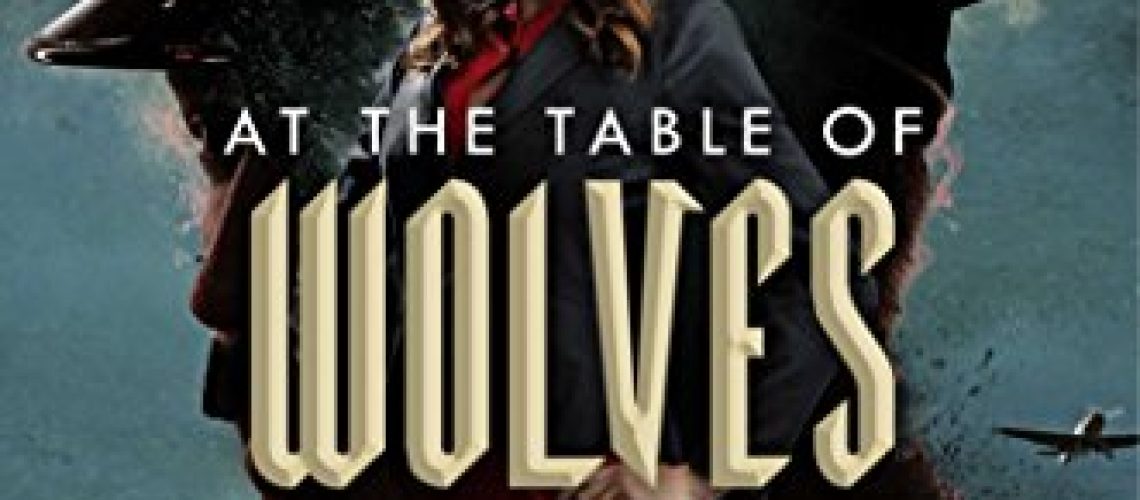Spies and Espionage are a genre of novels that is irresistible to science fiction and fantasy writers who want to mix some peanut butter in their chocolate. Cloak and Dagger, hidden agendas, betrayals, allegiances, loyalty and the glamour and seduction of the spy’s life. James Bond and his competitors, clones and remakes are just a fraction of what can be tapped, especially once someone adds science fiction and fantasy to the mix.
At the Table of Wolves by Kay Kenyon is the newest in that tradition, combining 1930s British espionage with superpowers. In the world of Kenyon’s novel, superpowers, here called Talents, started appearing after the devastation of World War I. How and why precisely this Bloom occurred is not explained in detail. It’s taken as a fact, and the repercussions of that event are playing out, more than a decade later. Intelligence agencies, governments, and just plain ordinary people are dealing with the fact that some people can now show feats of precognition, or reading objects, or seeing crimes, or, perhaps, having the preternatural ability to get people, without their volition, to spill things they would never dreaming of confessing. And it is that last talent that brings us to the heroine of the novel.

Born of an American mother and a British father, Kim is a bit of an outsider, as much as she has tried to fit in with the English countryside. The fact that she secretly IS a spill puts some distance between herself and the community around her. Even more importantly, the fact that she is a spill puts significant distance between her and her father. Her father’s apparently Nazi-sympathetic politics, too, are a secret sticking point between daughter and father. It is this relationship, its messiness, that really drives and makes this novel work. It is this relationship that this novel leans on heavily to succeed.
The plotting of the novel makes this something of a coming of age story, as Kim gets herself unwittingly entangled in both British and German plots — plots that could result in Germany gaining an overwhelming advantage over its rival, perhaps to the point of even being able to conquer it in a lightning campaign. Espionage and Spy novels are by their nature cloak and dagger, hiding in the shadows, actions and counteractions. The author does not overcomplicate matters terribly, the novel is more of a revealing and uncloaking of a relatively straightforward set of actions hidden by information control, personality conflicts, and the fog of (cold) war. Espionage and cold war spy games are expertly handled by the author.
The strength of the novel is not the worldbuilding, although the Talents delight me, as the author has thought out the implications of many of them, and has them make sense and not overpowered. Kim’s spill does not work on a conscious level, she couldn’t sit at a table having lunch with me and MAKE me spill, it would have to come naturally in the course of interaction. Other powers, as we see, also have their limits as well as advantages. And there are revelations about powers in the novel, and how they function, that to reveal would spoil the story, as part of the business of the novel and how it flows. The author has thought as much about how superpowers might be studied and investigated as their actual existence.
No, the strength of this novel is the characters and their relationships, and only works because those underpinning relationships do. We buy into the tangled relationship Kim has with her father, and with the primary antagonist, Erich Von Ritter. With Von Ritter, the author creates a seductively appealing villain, but never forgets to show us the reader that he is indeed, a villain. The dynamic and cat-and-mouse and tangled relationship and interactions Kim and Erich have in the book were a real highlight for me. The relationship between Kim and her father makes for an interesting parallel, and in the end Kim is left dealing with two different, powerful and dangerous men, in what is really very much a man’s world. The author handles all of this character tension and development wonderfully.
The end of this novel is only really the beginning of Kim’s story, as she takes further steps into a bigger world of spies and espionage, and of course the possible looming of a second world war. It’s past time that the cold war and pre cold war spies and espionage were made more widely used by authors in genre. Mike Martinez has the early Cold War covered with his MJ-12 novels. Charles Stross has explored some of this material in Laundry Files novels’ backstory as well. Other creators seem to be placing markers on WWII and later territory. And from what I can see so far, Kenyon is placing a marker on pre-World War II 1930s-era espionage, and I look forward to the next novel in Kim’s story, Serpent in the Heather.







